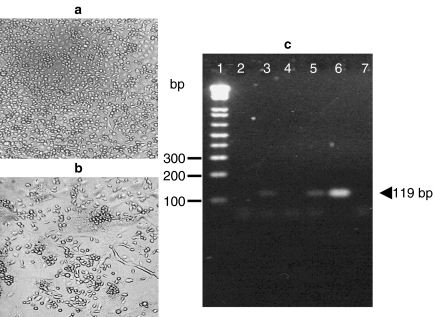Figure 1.
Cytopathic effects of the new dengue virus 2 (DV2) clinical isolate on target insect cells and RT-PCR from conventional target mosquito cells and from cultured explants of human skin. The classical mosquito cell-line C6/36 (Aedes albopictus) was used to test whether this new viral isolate from a patient would infect a conventional target cell. 107 C6/36 cells were infected using a multiplicity of infection of 0.1 PFU/cell in tissue-culture flasks of 25 cm2 (Corning, NY, USA) and humid atmosphere with 5% CO2 at 37 °C for 2 days. DV2 was added, since the beginning of culture, and 24 h later, the typical cytopathic effects were observed (b), compared with control non-infected cultures (a). To detect the negative-strand DV-RNA indicative of active viral replication, RT-PCR was done with RNA obtained from control-cultured non-inoculated and DV-inoculated skin explants, as well as conventional target (C6/36) mosquito cells. Lane 1: molecular weight markers, lane 2: cultured non-inoculated skin explants, lane 3: DV-inoculated explants cultured for 48 h, lane 4: cultured non-inoculated explants (72 h), lane 5: DV-inoculated explants cultured for 72 h, lane 6: mosquito cells infected with DV2 isolate and lane 7: PCR negative control. Arrowhead indicates the negative-strand viral amplicon (119 bp size). Results are representative of five different experiments from skin samples obtained from five individuals.

